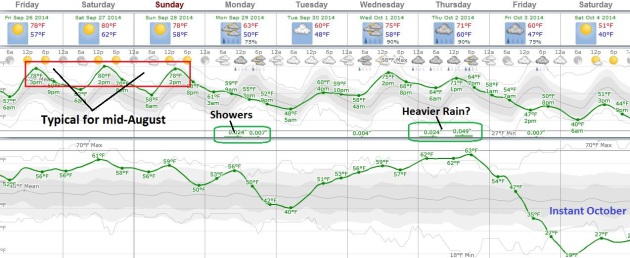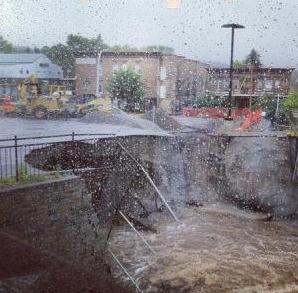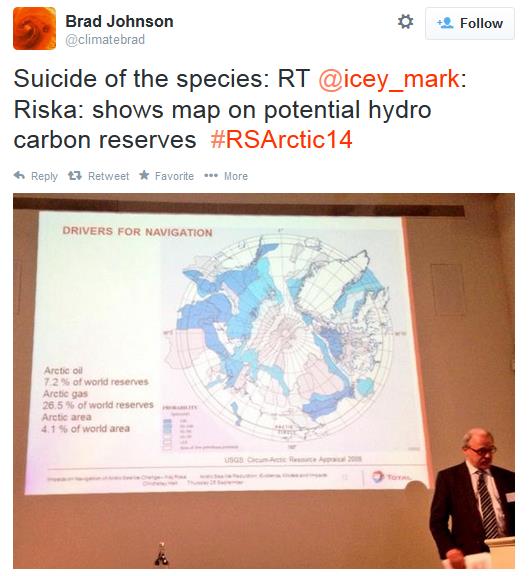77 F. high in the Twin Cities Thursday.
68 F. average high on September 25.
74 F. high on September 25, 2013.
September 25, 1980: Cold morning across Minnesota, with a low of 20 degrees at Tower and 16 at Embarrass.
September 25, 1942: 1.8 inches of snow fell in St. Cloud.

Greener Grass
You always want what you don’t have. My youngest son is in the military, based in San Diego, which arguably has the best climate in America. You’d think he’d be thrilled. “I feel like Bill Murray in “Groundhog Day”. Every day is the same – no variation. It hasn’t rained since I got here in April. I miss the seasons, the changes in weather” he complained. Really?
If every day was exactly like today, balmy, blue sky and 80 degrees, would you get bored? Would we start to take this stuff for granted? Let me try it for a few years and get back to you.
Consider this a cosmic reward for a fickle summer of June monsoons, July cold fronts and an early frost a couple weeks ago. Like something ordered up by the Minnesota Chamber of Commerce, today will (temporarily) restore your faith in Minnesota’s manic meteorology. The next few days will be more typical of mid-August; temperatures some 15F above average.
Fall color is peaking along the North Shore. Load up the kids in the station wagon and escape north/west of MSP for a kaleidoscope of color; a free show from Mother Nature.
A thundershower is possible Monday; steadier rain next Thursday – followed by a frost risk the first weekend of October.
Get off the couch. This can’t last.

Saturday Preview. The predicted national weather map Saturday morning, courtesy of UCAR in Boulder, shows an expansive high pressure system centered over the Great Lakes, southerly winds from the Plains into the Upper Midwest transporting temperatures to August-like levels. T-storms sprout over the southeastern USA and the Rockies, with steadier rain overspreading the Pacific Northwest.

Low to Mid 80s Saturday? Model guidance suggests Saturday may be the warmest day of this welcome warm spell, a few simulations showing a high of 83F at MSP Saturday afternoon. Not too shabby, considering the sun will be as high in the sky as it was back in mid-March. A cool-down is likely by the end of next week.

August Relapse. Shorts and T-shirts get one more workout into the weekend with temperatures 10-20F warmer than average for the end of September. A weak cool front arrives Monday with showers and possible thunder; heavier/steadier rain and storms Thursday herald the arrival of an October puff capable of sparking frost within 8-9 days. Guidance: Weatherspark.

Hanging On To Summer. GFS model guidance (NOAA) shows fine weather lingering from the Upper Midwest into the Great Lakes and New England; the pattern breaking down next week as Canada flings a cooler airmass south of the border. The tropics are still miraculously quiet.

First Metro Frost/Freeze? GFS guidance shows low temperatures dipping into the mid and upper 20s the morning of October 6, which seems reasonable (wrong word) considering the strength of this next cold front. This is pretty close to average for the first MSP frost, which tends to come during the first week of October most years.

Nation Fails To Address Coastal and Inland Flood Risks, Civil Engineer Society Says. If we don’t learn from history we’re doomed to repeat it, right? Here’s an excerpt of an eye-opening story at NOLA.com: “…If the devastating impacts of Sandy and the losses sustained in floods and hurricanes since Katrina were to be used as the measures of progress, the nation has failed to heed the call,” said the report, prepared by the society’s Task Committee on Flood Safety Policies and Practices. “Is anybody listening? That’s the question,” said Gerald Galloway, a University of Maryland engineering research professor and one of the authors of the report. “The question is why aren’t more people listening to what’s been said about flood risk in report after report after report…” (File photo: Reuters).

What Would Happen if “The Big One” Hit New York City Today? It Wouldn’t Be Pretty. Sandy was a mash-up of nor’easter and ex-hurricane; striking as a (huge) cold-core storm at high tide during a full moon, which amplified the impact of 80-mile hour winds at landfall. If a true Category 3-4 storm, similar to the Hurricane of 1812, hit the northeastern USA today the damage would be several orders of magnitude higher, according to an article at PropertyCasualty360; here’s an excerpt: “…One thing that most meteorologists agree on is that Sandy, though a unique storm in the way it merged with another storm giving it immense girth that covered nearly the entire Eastern United States, was a relatively weak storm. When it hit New Jersey, Sandy’s sustained wind speeds topped out at only 80 mph. Comparatively, the Norfolk-Long Island Hurricane had hurricane-force winds that extended well into Maine, with speeds topping 150 mph in some areas, according to the report. The damage from a Norfolk-Long Island sized hurricane today would decimate most of Long Island’s properties, Swiss Re said…”

Doppler On Your…Watch? Why not. A previous company, Digital Cyclone, was the first to put Doppler radar on a cell phone back in 2001. Now HAMweather/Aeris just launched an app that allows you to display Doppler, satellite imagery, forecasts and advisories/warnings on your app-enable Android watch. Full disclosure: the basic version of Aeris Weather Weather is free to consumers, and was created by developers at Media Logic Group, which I launched back in 2008.

Occupational Hazards of Working on Wall Street. I’m feeling a little better about my profession after reading this article at Bloomberg View; here’s an excerpt: “…The occupational hazards of Wall Street are more interesting — and not just because half the graduating class of Harvard still wants to work there. Some are obvious — for instance, the temptation, when deciding how to behave, to place too much weight on the very short term and not enough on the long term. Or the temptation, if you make a lot of money, to deploy financial success as an excuse for failure in other aspects of your life. But some of the occupational hazards on Wall Street are less obvious…”

How To Survive a Plane Crash. Here’s a cheerful thought; odds overwhelming favor you won’t have to put these tips into action, but the Boy Scout “Be Prepared” motto comes to mind. Here’s an excerpt from Huffington Post: “…Clubb explains that the key to survival is getting into the proper brace position: Bend forward as far as possible, keep your head down. Place your feet flat on the floor and slide them back. Your dominant hand goes on the back of your head. Protect that hand by placing the other hand over it. Do not interlock fingers. The goal is to ensure that the bones in the stronger hand aren’t broken so you can eventually unbuckle the seatbelt. Will members of the class ever use the training? Each day, 8.3 million people around the globe step aboard some 93,500 flights. They almost always land safely...”

ZEB Pilot House Generates Nearly 3 Times More Electricity Than It Requires. I still like the idea of selling (free) renewable energy back to my local utilility. Gizmag has the story – here’s a clip: “International architecture firm Snøhetta has partnered with Norway’s Research Center on Zero Emission Buildings (ZEB) and to design and build a remarkable experimental house that helps move the development of very efficient buildings forward. The ZEB Pilot House is claimed to generate almost three times the amount of electricity it requires, with the significant surplus available to help run an electric car, for example…”


TODAY: Warm sun. Stunningly nice. Winds: SE 10-15. High: near 80′
FRIDAY NIGHT: Clear and mild. Low: 60
SATURDAY: Plenty of sun, warm breeze. Dew point: 54. High: 80
SUNDAY: Blue sky, typical for mid-August. Wake-up: 61. High: 81
MONDAY: Clouds increase, T-shower risk. Wake-up: 60. High: 73
TUESDAY: Some sun, still warmer than average. Wake-up: 57. High: 76
WEDNESDAY: Unsettled, risk of thunder. Wake-up: 58. High: 75
THURSDAY: More numerous showers, T-storms, some heavy rain possible. Wake-up: 57. High: 73
Climate Stories…

Study Finds Global Sea Levels Rose Up To Five Meters Per Century At The End of The Last Five Ice Age Cycle. Yes, the climate has changed before, but never at the rate we’re now witnessing. Here’s an excerpt of a story at phys.org: “Land-ice decay at the end of the last five ice ages caused global sea-levels to rise at rates of up to 5.5 meters per century, according to a new study. An international team of researchers developed a 500,000-year record of sea-level variability, to provide the first account of how quickly sea-level changed during the last five ice age cycles….”
Photo credit above: Tiago Fioreze/Wikipedia.

Capitalism Is Saving The Climate, You Hippies. My favorite headline of the week. Protesting in front of Wall Street may be missing the point to some degree. Wall Street follows the money, and it turns out investors (institutional and private) are still pouring a lot of money into firms that promise a lower-carbon future, like Tesla and Solar City. Altruism? Maybe, but they’re just trying to make a buck. Keeping the profit motive alive and well will accelerate the green, sustainable solutions we’re going to need. As I keep saying, the best way to get someone to go green is to put more green back in their wallet. Here’s an excerpt from The Daily Beast: “…Of course, Wall Street firms aren’t doing this out of the goodness of their own hearts, although they do like the positive buzz such deals can generate. They’re doing is because they can make money doing so. And this is the real transformation we’ve seen in the last several years. The Occupy-like protesters might not like it, but renewable energy, efficiency, and sustainability have become big businesses, with huge needs for capital. You can’t crowdfund your way to stopping climate change.”

Sandia Labs Study: “It Is The Uncertainty Associated With Climate Change that Validates The Need To Act Protectively and Proactively.” Here’s an excerpt of a new Sandia Labs study focused on a state-wide breakdown of how climate volatility and greater extremes may impact GDP; Think Progress has the story “…The study finds that contrary to popular rhetoric, greater uncertainty about the impacts of climate change means greater economic risk, not less. Specifically, within an envelope covering 98% of the climate uncertainty as it pertains to rainfall alone, the U.S. economy is at risk of losing between $600 billion and $2.0 trillion and between 4 million and 13 million U.S. jobs over the next 40 years. Let’s examine how the study arrives at these estimates...”

Climate Action – Who Is Stopping Us? With all the other threats and risks lurking out there climate volatility just isn’t top of mind for many people. Odds are that will change in the very near future. Here’s a clip from a Huffington Post story: “…If rationality and economics were humanity’s guide to living on this planet, climate action would no longer need summits. The more successful clean energy solutions get, the more they are cutting into the profit margins of those few powerful companies whose business models depends on continued fossil fuel dependency. That´s why we agree with UN Secretary General Ban Ki-moon when he says “instead of asking if we can afford to act, we should be asking what is stopping us, who is stopping us, and why?” We would add to this another question: for how long? Today, it is interests of the fossil fuel industries — not technology nor economics — which are the only obstacle to securing a safe future for us and our children on this planet. And they know it, too…”


Jon Steward Nails The Insane Reason We Need To Keep Talking About Climate Change. Yes, let’s deny basic science as long as possible. Here’s a video clip and story excerpt from Business Insider: “If 99.9% of the scientific literature shows that climate change is real and worsened by human action, why do we still need marches like the one that recently flooded the streets of New York City? It’s an appropriate question, and one that comedian Jon Stewart answers eloquently in a recent Daily Show episode. As he notes on the show, some members of the White House Representatives Committee on Science, Space and Technology hold some very strange and unscientific views on the matter...”

Why The Rockefellers Rejected Big Oil. Here’s a clip from The Daily Beast: “…The Rockefellers aren’t divesting merely out of altruism. They believe that companies trafficking in fossil fuels will eventually face financial problems. But for Reynolds and Robbins, obeying their consciences came with a price tag...”
Image credit: Elena Scotti/The Daily Beast.

